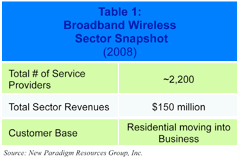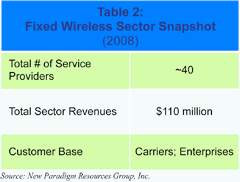|
|

article page
| 1
| 2
| 3
| 4
|
station providing data access to many, often hundreds, of unique subscribers.
For years, a large number of wireless internet service providers, or WISPs, provided basic internet connectivity to underserved communities, particularly in rural areas. The advent of more robust and higher-speed point-to-multipoint wireless technologies, most notably pre-standard versions of WiMAX (the industry marketing name for an evolving IEEE standard), have enabled WISPs and new entrants to deliver DSL-like speeds.
While broadband wireless has yet to break through to the mass market or find a killer app, the sector’s show horse, Clearwire, appears to be getting off the ground finally. The company cut deals with Sprint in 2008 that brought Clearwire additional financial backing, as well as access to significant network assets. The company also launched its mobile WiMAX deployment in Baltimore, with more metropolitan rollouts planned for 2009.( Clearwire currently offers pre-WiMAX service in about 50 markets.) The rest of the sector has matured as well, as multiple acquisitions have begun the process of rolling up some of the smaller providers, all towards building up a significant number of regional presences.
A point of interest for technology vendors will be the sheer number of broadband wireless providers in operation. NPRG estimates that there are some 2,200 of these carriers serving markets of various sizes and drawing in a significant pool of potential customers who have moved away from wireline service. (Source: Broadband Wireless Sector Analysis Report (2008), New Paradigm Resourced Group, Inc., Chicago, IL. ) While few of these providers currently have deep pockets, most of them certainly have significant back office challenges.
Fixed Wireless
Fixed wireless telecommunications involves wireless transmission of service to and from fixed locations, at frequencies above 10 GHz. By sticking to more reliable licensed spectrum
|
|
While broadband wireless has yet to break through to the mass market or find a killer app, the sector’s show horse, Clearwire, appears to be getting off the ground finally. |
|

in the higher-bandwidth microwave or millimeter wave frequencies above 10 GHz, fixed wireless remains distinct from other wireless technologies operating in unlicensed spectrum below 6 GHz.
Fixed wireless is capable of providing carrier-grade bandwidth and reliability, and does so at price points appropriate for that level of service. Microwave, of course, has been deployed for years in cellular backhaul and long-distance relay applications. On the retail side, the technology has by and large been deployed towards achieving physical network diversity, and as a redundant backup for large enterprises, especially in verticals where bandwidth is mission-critical, such as finance. This group of end-users require levels of service comparable to those of carriers and are willing to pay.
Fixed wireless is now getting a second look from enterprise, thanks to stiffer internal and external requirements for data backup and disaster recovery. A wide range of documents—email, contracts, CAD files, blueprints, sales quotes, contact lists, health records, databases, recorded phone conversations, to name a few—are now archived electronically. All this is done in order to meet standards set for litigation preparedness and regulatory compliance, making the storage and retrieval of these resources a primary consideration in IT planning. Following several high-profile disasters that destroyed companies' on-site storage, various industry organizations advise, and some legislation (e.g., Sarbanes-Oxley Act in 2002) mandates, that companies maintain certain levels of disaster planning, in particular public corporations.
article page
| 1
| 2
| 3
| 4
| |
|
|
|





